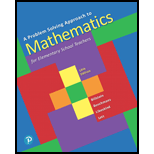
 |
a. Describe the transformation that takes
b. Construct any
Want to see the full answer?
Check out a sample textbook solution
Chapter 14 Solutions
A Problem Solving Approach To Mathematics For Elementary School Teachers (13th Edition)
- 4 HW/ os x ex dx 2X 3 6054x dxarrow_forwardExample: If ƒ (x + 2π) = ƒ (x), find the Fourier expansion f(x) = eax in the interval [−π,π]arrow_forwardThis box plot represents the score out of 90 received by students on a driver's education exam. 75% of the students passed the exam. What is the minimum score needed to pass the exam? Submitting x and Whickers Graph Low 62, C 62 66 70 74 78 82 86 90 Driver's education exam score (out of 90)arrow_forward
- Example: If ƒ (x + 2π) = ƒ (x), find the Fourier expansion f(x) = eax in the interval [−π,π]arrow_forwardPlease can you give detailed steps on how the solutions change from complex form to real form. Thanks.arrow_forwardExamples: Solve the following differential equation using Laplace transform (e) ty"-ty+y=0 with y(0) = 0, and y'(0) = 1arrow_forward
- Examples: Solve the following differential equation using Laplace transform (a) y" +2y+y=t with y(0) = 0, and y'(0) = 1arrow_forwardTemperature for Sudbury (degrees Celsius) 3. The following table gives the mean monthly temperatures for Sudbury, Ontario and Windsor, Ontario. Each month is represented by the day of the year in the middle of the month. Month Day of Year Temperature for Windsor (degrees Celsius) January 15 -13.7 -4.7 February 45 -11.9 -3.8 March 75 -5.9 2.3 April 106 3.0 8.7 May 136 10.6 14.6 June 167 15.8 20.2 July 197 18.9 22.6 August 228 17.4 22.0 September 259 12.2 17.9 October 289 6.2 11.5 November 320 -1.2 4.8 December 350 -10.1 -1.2 a) Create a scatter plot of temperature vs. day of the year for each city. b) Draw the curve of best fit for each graph. c) Use your graphs to estimate when the temperature increases fastest, for each set of temperature data. Explain how you determined these values. d) Use your graphs to estimate the rate at which the temperature is increasing at the two times from question 3. e) Determine an equation of a sinusoidal function to model the data for each cityarrow_forwardNot use ai pleasearrow_forward
- Algebra & Trigonometry with Analytic GeometryAlgebraISBN:9781133382119Author:SwokowskiPublisher:Cengage
 Trigonometry (MindTap Course List)TrigonometryISBN:9781305652224Author:Charles P. McKeague, Mark D. TurnerPublisher:Cengage Learning
Trigonometry (MindTap Course List)TrigonometryISBN:9781305652224Author:Charles P. McKeague, Mark D. TurnerPublisher:Cengage Learning

